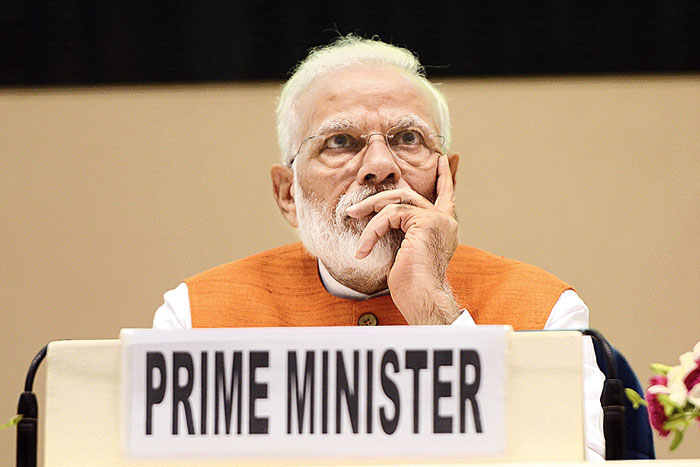The Indian economy grew at its slowest pace in more than six years at 5 per cent in the first quarter of 2019-20, deepening worries about subdued factory output and resultant job losses.
It also fanned concerns about the Narendra Modi government’s ability to crank up demand amid clear indications that urban consumption had also started to slacken after rural demand went into a deep rut several quarters ago.
No one had expected the economy to slow down so sharply with economists polled ahead of the data release by the Central Statistics Office expecting it to dip to 5.7 per cent — just a little lower than the 5.8 per cent in the previous quarter.
“This is shocking; no one expected it to be so low,” said Biocon founder Kiran Mazumdar-Shaw. “If this is not a wake-up call signalling an economic emergency, then what is?”
This is the slowest growth since the 4.9 per cent growth recorded in April-June 2012-13. In the same quarter last year, the economy was humming along at a relatively pacy 8 per cent.
India’s bragging rights about being the fastest growing economy again went up in smoke. China reported a growth rate of 6.2 per cent in the April-June quarter of 2019, its weakest expansion in the past 27 years.
The real big worry is that growth in the manufacturing sector — which has a big bearing on employment — measured by gross value added shrank to 0.6 per cent in the first quarter from 12.1 per cent expansion a year ago, and 3.1 per cent in the previous quarter.
Growth in the farm sector was also subdued at 2 per cent compared with 5.1 per cent in the corresponding period of the previous fiscal.
Two other sectors that generate employment — construction and mining —
also reported slower GVA growth at 5.7 per cent and 2.7 per cent. In the previous quarter, they had grown at 7.1 per cent and 4.2 per cent, respectively.
Chief economic adviser Krishnamurthy Subramanian attributed the slowdown to “endogenous and exogenous factors like deceleration in developed economies, and the trade conflict”.
He said a similar phenomenon had been observed in 2013-14 when growth was around 5 per cent.
Subramanian continued to insist that there were some green shoots in the economy, pointing to the electricity and power generation sector which had reported an 8.6 per cent growth.
He also said capacity utilisation had improved to 76.5 per cent.
But analysts were not ready to buy this argument. “The government needs to address structural and cyclical issues to address the economic slowdown,” said Devindra Pant, chief economist of India Ratings, an arm of Fitch Ratings, citing a slowdown in the sales of autos and construction and a dip in consumer demand.
Consumption growth is the lowest in 18 quarters, he said.
“Declining savings, especially household saving, is a major challenge for the economy and is leading to a structural growth slowdown. The fiscal space to undertake counter cyclical measures are very limited but we believe the government will undertake some measures to provide a short-term boost to the economy,” Pant added.
Private consumption, reflected in private final consumption expenditure, grew by 3.1 per cent in Q1 compared with 7.2 per cent in the fourth quarter of the last fiscal.
Investments, as reflected by gross fixed capital formation, grew at 4.4 per cent in Q1 as against 3.6 per cent in Q4.
Aditi Nayar, principal economist with Icra, said: “Regardless of the monetary easing and the measures announced so far by the government to support the economy, some of the constraints to economic growth, including the moderate capacity utilisation levels, cost of land acquisition, and weak outlook for farm incomes, would persist. Although the pace of expansion is expected to rise in the subsequent quarters from the multi-year low recorded in Q1 FY2020, GVA and GDP growth are expected to print sub-6.5 per cent in the current fiscal,” she said.
The slackening growth rate could prompt the Reserve Bank of India’s monetary policy committee to cut interest rates by at least 25 basis points in October. This year, the central bank has cut the benchmark repo rate by 110 basis points.
The Modi government is taking steps to try and revive growth, and recently got the windfall help from the Reserve Bank of India of Rs 1.76 lakh crore, which could provide some heft to the finance ministry.
On Friday, the ministry announced the merger of 10 State-owned banks in a bid to reform the banking sector, which is battling a mountain of debt and struggling to boost lending.
Finance minister Nirmala Sitharaman has indicated that more steps to boost the economy would be announced in the coming weeks to address the concerns of specific sectors, including real estate.
The Reserve Bank had marginally lowered the GDP growth projection for 2019-20 to 6.9 per cent from 7 per cent projected earlier. But it may have to take a hard look at its forecast once again.










